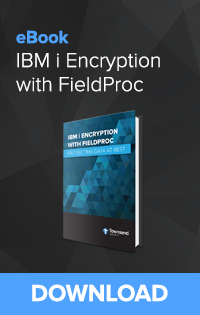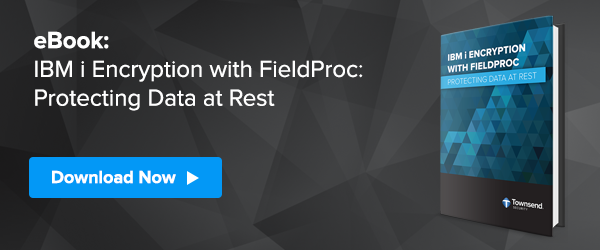Excerpt from the eBook "IBM i Encryption with FieldProc - Protecting Data at Rest."
Encryption in FieldProc
It goes without saying that your FieldProc application will need to use an encryption library to perform encryption and decryption operations. IBM provides an encryption software library as a native part of the IBM i operating system. It is available to any customer or vendor who needs to implement encryption and decryption in their FieldProc programs.
 Unfortunately the native IBM encryption library is very slow. This might not be noticeable when encrypting or decrypting a small amount of data. But batch operations can be negatively impacted. The advent of AES encryption on the Power8 processor has done little to mitigate the performance issue with encryption. IBM i customers and third party vendors of FieldProc solutions should use caution when implementing FieldProc using the native IBM i AES software libraries. They are undoubtedly accurate implementations of AES encryption, but suffer on the performance front.
Unfortunately the native IBM encryption library is very slow. This might not be noticeable when encrypting or decrypting a small amount of data. But batch operations can be negatively impacted. The advent of AES encryption on the Power8 processor has done little to mitigate the performance issue with encryption. IBM i customers and third party vendors of FieldProc solutions should use caution when implementing FieldProc using the native IBM i AES software libraries. They are undoubtedly accurate implementations of AES encryption, but suffer on the performance front.
Key Management
An encryption strategy is only as good as the key management strategy, and it is difficult to get key management right. For companies doing encryption the most common cause of an audit failure is an improper implementation of key management. Here are a few core concepts that govern a good key management strategy:
- Encryption keys are not stored on the same system as the sensitive data they protect.
- Security administrators of the key management solution should have no access to the sensitive data, and database administrators should have no access to encryption key management (Separation of Duties).
- On the IBM i system this means that security administrators such as QSECOFR and any user with All Object (*ALLOBJ) should not have access to data encryption keys or key encryption keys.
- More than one security administrator should authenticate before accessing and managing keys (Dual Control).
- All access to encryption keys should be logged and audited. This includes use of encryption keys as well as management of keys.
- Encryption keys should be mirrored/backed up in real time to match the organization’s standards for system availability.
Encryption Key Caching
Encryption keys are often used frequently when batch operations are performed on sensitive data. It is not unusual that a batch program would need to perform millions or tens of millions of encryption and decryption operations. While the retrieval of an encryption key from the key server may be very efficient, performance may suffer when keys need to be retrieved many times. This can be addressed through encryption key caching in the local environment.
Secure key caching should be performed in separate program modules such as a service program and should not be cached in user programs where they are more subject to discovery and loss. Any module caching an encryption key should have debugging options disabled and visibility removed. Secure key caching is critical for system performance and care should be taken to protect storage.
Encryption Key Rotation
Periodically changing the encryption keys (sometimes called “key rotation” or “key rollover”) is important
to the overall security of your protected data. Both data encryption keys (DEK) and key encryption keys (KEK) should be changed at appropriate intervals. The appropriate interval for changing keys depends on a number of variables including the amount of data the key protects and the sensitivity of that data, as well as other factors. This interval is called the cryptoperiod of the key and is defined by NIST in Special Publication 800-57 “Key Management Best Practices”. For most IBM i customers rotation of data encryption keys should occur once a year and rotation of the key encryption keys should occur no less than once every two years.

